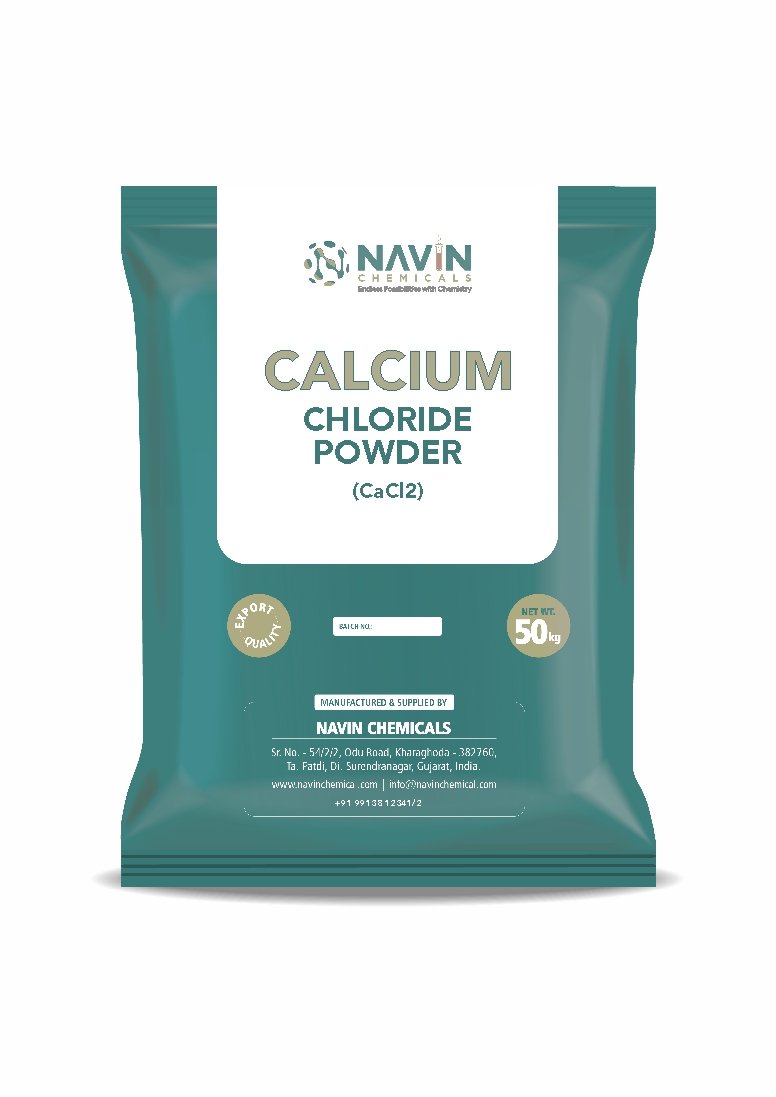

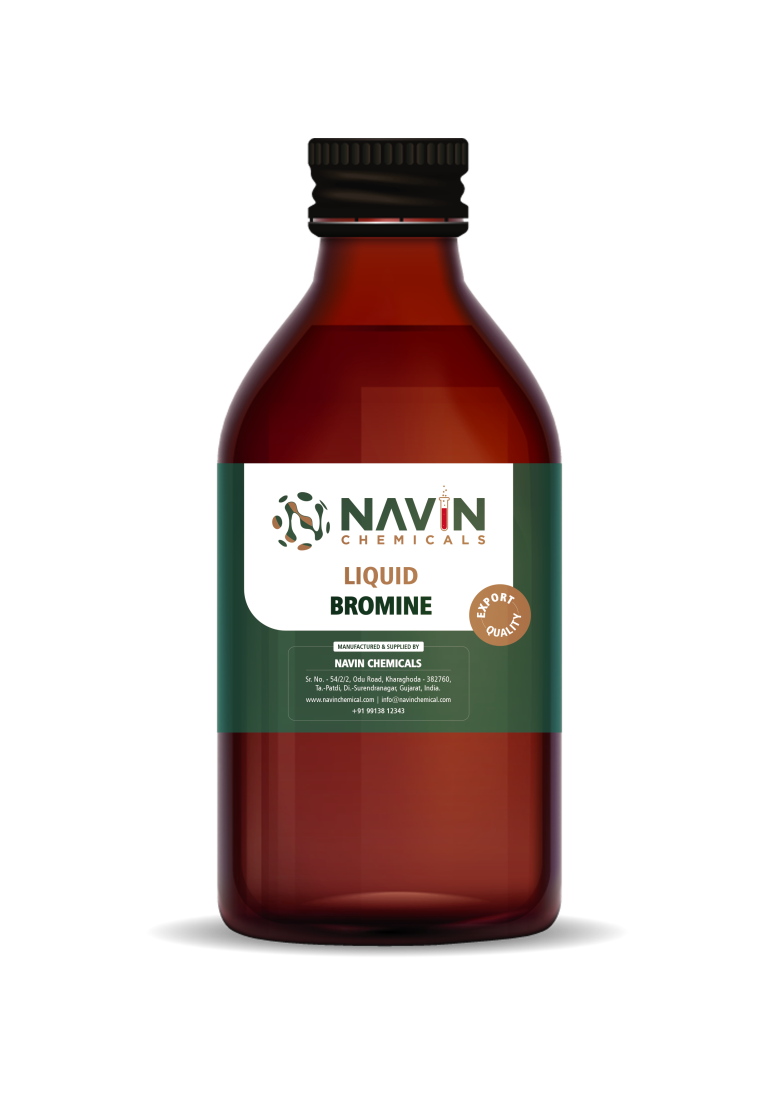


| CHEMICAL FORMULA | Br2 |
| PHYSICAL FORM | Liquid |
| APPEARANCE | Reddish Brown |
| CAS NO | 7726-95-6 |
| GRADE | Virgin |
| HS CODE | 28013020 |
| PACKING | Six Bottles of 3 Kg each packed in Plastic Crates, ISO containers of 8 KL & 6 KL capacity. |
Bromine biologically is present in almost every living thing in very small amounts, even though there is no biological use that is known in humans. Bromine is a toxic element and has an irritating effect on the skin. Bromine is not exactly a friendly element, but still is a very useful one!
Bromine, a heavy, mobile, reddish-brown liquid with an intensely irritating odour, is the only non-metallic element that is a liquid at normal room temperatures.
Insecticides: Bromine is used in making insecticides like Methyl Bromine. Some of these products are also used for fumigation of palletized cargo for shipping.
Dyestuff and pigments: Bromine is commonly used in color pigments & dyestuff largely for textile purposes. Petrochemicals: Bromine has a major use in the petrochemical sector for manufacturing chemicals like hydro bromic acid.
Pharmaceuticals: Bromine is widely used in many lifesaving drugs in the form of various bromine based compounds like magnesium bromine, Sodium Bromide, etc.
Flame Retardants: Major flame retardants have bromine-based compounds.
Agriculture sector: Bromine compounds have long been used to kill the soil and stored grains pests.




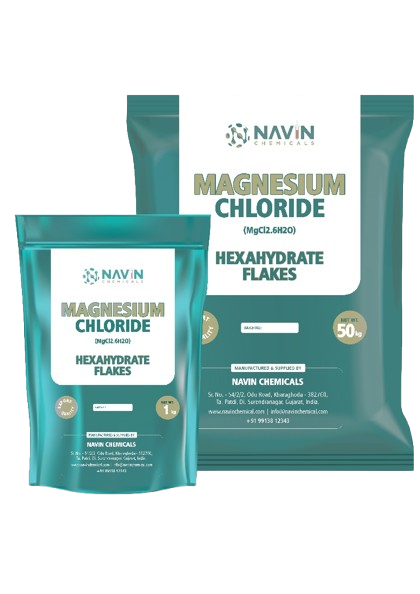

| CHEMICAL FORMULA | MgC12.6H20 |
| PHYSICAL FORM | Flakes |
| APPEARANCE | White |
| CAS NO | 7791-18-6 |
| GRADE | Technical |
| HS CODE | 28273100 |
| PACKING | 1,25.50,1000 Kg (PP,HDPP,BOPP) |
Magnesium Chloride is the name for the chemical compound with the formula MgCl2 and its various hydrates MgCl2(H20). This salt is highly ionic and a halide and thus very much soluble in water. That is exactly where it is mostly extracted from seawater or brine.
Magnesium Chloride is actually used in bath salts alongside Epsom salt and also used in the manufacture of tofu, where its role is to coagulate the soy milk to produce t to produce the rubbery curd. Magnesium Chloride Flakes can rejuvenate the ageing body which means that it is often found as a mineral supplement in health food shops where it is used in the industry as a nutrient supplement.
In the construction industry for production of magnesia cement
Magnesium tiles and magnesite slabs
In prepare of millstones and marble/granite polishing stones
In oil & gas industry as a component of drilling fluids
In textile industry for stabilization in carpet dyeing
In agriculture sector as fertilizer
Used for dust suppression




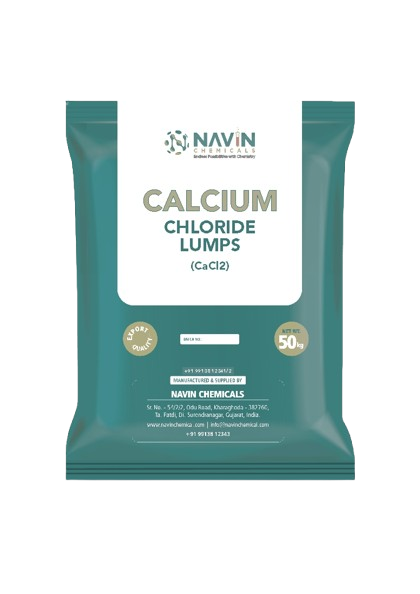

| CHEMICAL FORMULA | CaC12 |
| PHYSICAL FORM | Lumps |
| APPEARANCE | Pure White |
| CAS NO | 10043-52-4 |
| GRADE | Industrial and Techanical |
| HS CODE | 28272000 |
| PURITY | 72-75% |
| PACKING | 1,25,50,1000 kg (PP,HDPP,BOPP) |
Calcium Chloride Lump is an ionic compound of calcium and chlorine. It is highly soluble in water and it is deliquescent. It is a salt that is solid at room temperature, and it behaves as a typical ionic halide. The chemical formula of Calcium Chloride Lump (NH4)2CO3 with molecular weight 96.09 g/mol. The density of Calcium Chloride Lump is 0.745 g/ml (at 20 °C), The Melting point and boiling point of Calcium Chloride Lump is 782 °C and 1935 °C respectively it is highly soluble in ethanol.
It is used in food additives.
It is used as a fungicide.
It is used as a plant growth regulator,
It is used as adsorbents and absorbents.
It is used as a dust suppressant
It is used in laboratory chemicals.
It is used as agricultural chemicals (non-pesticidal).
It is used in food and medicines, it is a source of calcium ions and has various other uses.




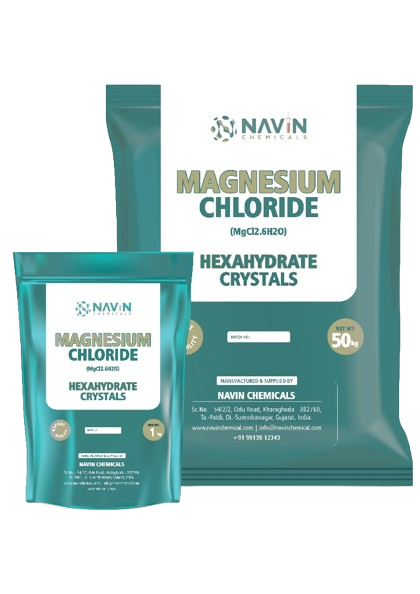

| CHEMICAL FORMULA | MgC12.6H20 |
| PHYSICAL FORM | Crystals |
| APPEARANCE | A Colourless Crystals |
| CAS NO | 7791-18-6 |
| GRADE | Technical Pharma |
| HS CODE | 28273100 |
| PACKING | 25,50 (PP, HDPP, BOPPI) |
We are manufacturers and suppliers of Magnesium Chloride Hexahydrate Crystals in Kharaghoda, Gujarat, India. The offered powder is checked on various quality parameters under the surveillance of skilled professionals.
Navin Chemical's product range includes a wide range of Magnesium Chloride Hexahydrate Crystals. With enriched industrial experience and knowledge, we are providing an excellent range of Magnesium Chloride Hexahydrate Crystals in India.
This powder is available in the market at industry leading prices to our customers. with a persistent quality round the year.
Pharmaceutical industry
Infantile diets production unit
Food compliments manufacturing industry
Preparation of salts for sea aquarium
Preparation of Magnesium Metal




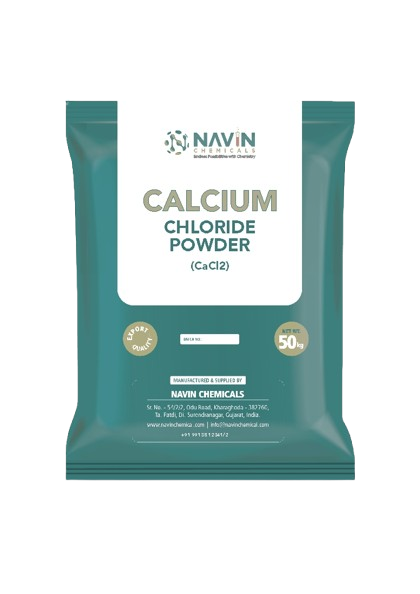

| CHEMICAL FORMULA | CaCl2 |
| PHYSICAL FORM | Powder |
| APPEARANCE | Pure White |
| CAS NO | 10043-52-4 |
| GRADE | Industrial and Techanical |
| HS CODE | 28272000 |
| PURITY | 75-77% and 94% |
| PACKING | 25,50,1000 kg (PP,HDPE) |
Calcium Chloride Lump is white to off-white solid, calcium salt and an inorganic chloride. Calcium Chloride Lump is an ionic compound of calcium and chlorine. It is highly soluble in water and it is deliquescent. It is a salt that is solid at room temperature, and it behaves as a typical ionic halide. The chemical formula of Calcium Chloride Lump (NH4)2CO3 with molecular weight 96.09 g/mol. The density of Calcium Chloride Lump is 0.745 g/mL (at 20 °C). The Melting point and boiling point of Calcium Chloride Lump is 782 °C and 1935 °C respectively.it is highly soluble in ethanol.
It is used in food additives.
It is used as a fungicide.
It is used as a plant growth regulator,
It is used as adsorbents and absorbents.
It is used as a dust suppressant
It is used in laboratory chemicals.
It is used as agricultural chemicals (non-pesticidal).
It is used in food and medicines, it is a source of calcium ions and has various other uses.







| CHEMICAL FORMULA | HBr |
| PHYSICAL FORM | Liquid |
| APPEARANCE | Clear, colorless to pale yellow |
| CAS NO | 10035-10-6 |
| GRADE | Reagent Grade |
| HS CODE | 28111990 |
| PACKING | HDPE Drums/IBC |
Hydrobromic Acid (HBr) is a strong acid that is composed of hydrogen bromide dissolved in water. It is a colorless or pale yellow solution with a pungent odor, and it is highly corrosive. It is commonly used in various industrial and laboratory applications.
It is a highly reactive and strong acid, primarily used in industrial applications that require the unique reactivity of bromine in a liquid acid form.
Organic Synthesis: Hydrobromic acid is used in the synthesis of alkyl bromides by reacting with alcohols (a substitution reaction), which are intermediates in the production of pharmaceuticals, agricultural chemicals, and surfactants.
Bromination: It is used to produce bromine-based chemicals, such as bromides, brominated compounds, and in the production of flame retardants.
Production of Pharmaceuticals: Hydrobromic acid is involved in the synthesis of various pharmaceutical compounds, including antibiotics, sedatives, and antiseptics.
Water Treatment: It is also used in water treatment processes to adjust pH and remove unwanted ions from water.

Catalyst in Chemical Reactions: In some reactions, hydrobromic acid acts as a catalyst, facilitating processes like esterification or halogenation.
Food and Beverage Industry: In food processing, hydrobromic acid is used to assist in the removal of unwanted impurities, such as fats or proteins, although its use is regulated.
Polymer Chemistry: It plays a role in the synthesis of certain types of polymers, especially in the creation of polybromides used as flame retardants.






| CHEMICAL FORMULA | CaBr2 |
| PHYSICAL FORM | Liquid/Powder |
| APPEARANCE | White crystalline solid or powder; in aqueous form, it is a colorless solution. |
| CAS NO | 7789-41-5 |
| GRADE | Industrial and Techanical |
| HS CODE | 28275990 |
| PACKING | Liquid : HDPE Drums/IBC |
| POWDER | 25 kg HDPE/1000 Kg Jumbo |
Calcium Bromide (CaBr2) is an inorganic compound consisting of calcium and bromine. It is a white crystalline solid that is highly soluble in water. Calcium bromide is used in a variety of industrial applications due to its ability to stabilize solutions, improve chemical reactions, and act as a source of bromide ions.
Calcium bromide is used in several key industries, owing to its physical and chemical properties. Here are some of its most common applications:
a. Drilling Fluids in Oil and Gas Industry
Well Completion: Calcium bromide brine is used in completion fluids for oil and gas wells.
Lost Circulation: It helps control lost circulation in drilling operations by preventing excessive fluid loss.
b. Fire Extinguishing Agents

Calcium bromide is used in fire suppression systems, particularly in dry chemical fire extinguishers and fire retardant chemicals. It acts as a source of bromine, which helps in preventing the combustion process. Calcium bromide has been used in combination with other chemicals to enhance the effectiveness of fire extinguishing agents.
c. Chemical Synthesis and Bromination Reactions
Calcium bromide is used in organic synthesis as a source of bromide ions (Br?) in bromination reactions. Bromine-containing compounds are widely used in the manufacture of various pharmaceuticals, pesticides, and flame retardants. Some key uses include:
Bromination of Aromatic Compounds: To produce brominated derivatives used in drug formulations and pesticides. Production of Brominated Solvents: Used in cleaning, degreasing, and other chemical processes.
d. Photography Industry
Calcium bromide has been historically used in the manufacture of photographic materials, such as photographic emulsions. These emulsions require bromide ions to create a sensitive surface on photographic films and plates. Though less common today due to digital photography, this application remains relevant in specialized fields like archival or artistic photography.
e. Water Treatment
Calcium bromide is used in water treatment applications to remove unwanted contaminants or as a biocide. It can also be used in pool water treatment, especially for maintaining the proper pH balance and controlling microbial growth. Swimming Pools: A calcium bromide solution can be used as an alternative to chlorine to sanitize and disinfect pool water.
f. Dust Control
In construction and mining, calcium bromide is sometimes used for dust suppression. It is added to soil or roads to prevent dust from becoming airborne, especially in arid or dry environments. The hygroscopic nature of calcium bromide helps to absorb moisture, which reduces dust levels.
g. Pharmaceutical Applications
Calcium bromide is used in some pharmaceutical formulations, especially for its sedative and anti-convulsant properties. Historically, it was used as a sedative to treat conditions like anxiety, epilepsy, and nervous disorders, although it is less commonly used in modern medicine due to the availability of more effective drugs.
h. Analytical Reagent
In laboratories, calcium bromide can be used in various analytical procedures as a reagent in reactions requiring a bromide ion source. It may also be used in titration experiments or in complexometric analysis.






| CHEMICAL FORMULA | NaBr |
| PHYSICAL FORM | Liquid/Powder |
| APPEARANCE | White crystalline solid or powder; in aqueous form, it is a colorless solution. |
| CAS NO | 7647-15-6 |
| GRADE | Industrial and Techanical |
| HS CODE | 28275110 |
| PACKING | Liquid : HDPE Drums/IBC |
| POWDER | 25 kg HDPE/1000 Kg Jumbo |
Sodium Bromide (NaBr) is an inorganic salt composed of sodium and bromine. It appears as a white crystalline powder or colorless crystalline solid in its pure form. Sodium bromide is highly soluble in water and is widely used in various industrial, chemical, and laboratory applications.
Sodium Bromide (NaBr) is an inorganic salt composed of sodium and bromine. It appears as a white crystalline powder or colorless crystalline solid in its pure form. Sodium bromide is highly soluble in water and is widely used in various industrial, chemical, and laboratory applications.
a. Oil and Gas Industry:
One of the major uses of sodium bromide is in the oil and gas industry. It is used in the formulation of brine solutions for drilling fluids, especially in situations where high-density brines are required to prevent blowouts during drilling. Sodium bromide brines are known for their ability to stabilize the wellbore and help control pressure.
b. Water Treatment and Swimming Pools:
Sodium bromide is used in water treatment applications, particularly in swimming pools and spa pools, where it acts as a disinfectant. When combined with chlorine, it forms bromine, which is a stronger disinfectant and more stable at high temperatures, making it ideal for hot tubs and spas.

c. Photography:
Sodium bromide is historically used in the photographic industry to make light-sensitive compounds. It reacts with silver salts (like silver nitrate) to form silver bromide, which is then used in traditional photographic film and paper.
Photographic Film: Silver bromide is still used in some specialized photography applications, although digital photography has largely replaced traditional methods.
d. Chemical Synthesis:
Sodium bromide is used in organic synthesis as a source of bromine. It is involved in bromination reactions, where it is used to replace hydrogen atoms in organic molecules with bromine atoms, forming alkyl bromides, which are important intermediates in the production of pharmaceuticals, dyes, and other chemicals.
Brominating Agent: Sodium bromide is an excellent source of bromine for producing various brominated organic compounds.
e. Pharmaceutical Applications:
Sodium bromide has been used in pharmaceutical formulations as a sedative or anti-anxiety agent, although its use in modern medicine has decreased in favor of other compounds. It is still occasionally found in formulations designed to treat seizures or to promote calmness.
f. Fire Retardants:
Sodium bromide is used in the formulation of certain fire retardants. When heated, sodium bromide decomposes and releases bromine, which can help to prevent the spread of fire by interfering with the combustion process.
g. Agriculture:
In the agricultural industry, sodium bromide is sometimes used as a pesticide or fungicide to treat crops and prevent damage from pests or diseases.





| CHEMICAL FORMULA | NaCl |
| PHYSICAL FORM | crystalline solid |
| APPEARANCE | White crystalline solid or granular (depends on form) |
| CAS NO | 7647-14-5 |
| GRADE | Industrial / Food |
| HS CODE | 25010010 |
| PACKING | PP/HDPE (25,40,50,100,1200 Kg) |
Salt (Chemically known as Sodium Chloride or NaCl) is one of the most widely used and essential substances in the world. It is a white crystalline mineral that is primarily composed of sodium and chlorine. Salt has a long history of use in food preservation, seasoning, and industrial applications. It is commonly harvested from seawater or mined from salt deposits and is available in various forms including rock salt, sea salt, and table salt, each having slightly different properties and uses.
Salt has a wide variety of uses, ranging from essential roles in food and health to critical industrial applications. Here are some of the key uses:
a. Food and Culinary Uses:
Seasoning: The most common use of salt is as a flavor enhancer in food. It is used to season, preserve, and enhance the taste of countless dishes.
Food Preservation: Salt is essential in the preservation of food through salting methods such as pickling, curing, and brining, which prevent microbial growth by drawing moisture out of food.
b. Industrial Uses:
Chlorine Production: One of the most significant industrial applications of salt is its use in the production of chlorine (Cl2), sodium hydroxide (NaOH), and hydrogen (H2) through the electrolysis of salt water. These chemicals are crucial in the production of plastics, solvents, detergents, and other chemicals.

Water Treatment: Salt is used in water softening processes to remove calcium and magnesium ions that cause hardness in water. It is also used in reverse osmosis systems and other water purification methods.
c. Pharmaceutical and Healthcare Uses:
Electrolyte Replacement: Sodium chloride is used in intravenous fluids (IVs) to replenish electrolytes in patients suffering from dehydration or other conditions that cause an imbalance in bodily fluids.
Oral Rehydration Solutions (ORS): Salt is a key component in oral rehydration salts (ORS), which are used to treat dehydration caused by diarrhea.
Saline Solutions: Salt solutions are used for nasal irrigation, wound care, and eye care, as they are isotonic with bodily fluids and help in cleaning and soothing.
d. Agriculture:
Animal Feed: Salt is an essential component in livestock feed, providing animals with the sodium and chloride ions they need for proper hydration and cellular function.Fertilizer Production: Salt is sometimes used in the production of certain fertilizers, providing sodium as an essential micronutrient for plant growth.
Animal Feed: Salt is an essential component in livestock feed, providing animals with the sodium and chloride ions they need for proper hydration and cellular function.Fertilizer Production: Salt is sometimes used in the production of certain fertilizers, providing sodium as an essential micronutrient for plant growth.
e. Cosmetics and Personal Care:
Exfoliants: In skincare, salt is used as an abrasive in scrubs and exfoliating products to remove dead skin cells. Bath Salts: Salt is often used in bath products for its soothing and relaxing properties. Preservative: Salt also serves as a preservative in some cosmetic formulations by preventing the growth of microbes.



